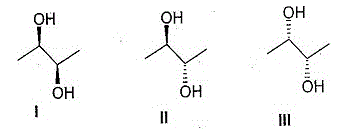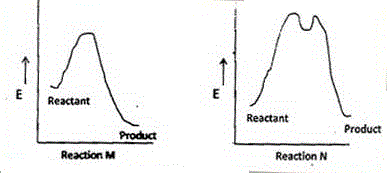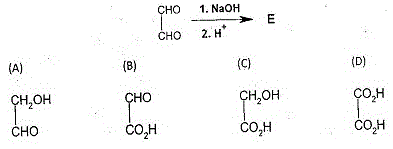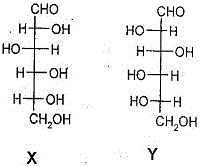1. The emission spectrum of hydrogen discovered first and the region of the electromagnetic spectrum in which it belongs, respectively are
(A) Layman, ultraviolet (B) Layman, visible (C) Balmer, ultraviolet (D) Balmer, visible
2. The electronic configaration of Cu is
(A) Ne3s23p63d94s2 (B) Ne3s23p63d104s1
(C) Ne3s23p63d34s24p6 (D) Ne3s23p63d54s24p4
3. As per de Broglie's formula a macroscopic particle of mass 100 gm and moving at a velocity of 100 cm s-1 will have a wavelength of
(A) 6.6×10−29 cm (B) 6.6×10−30 cm (C) 6.6×10−31 cm (D) 6.6×10−32 cm
4. For one mole of a ideal gas the slope of V vs. T curve at constant pressure of 2 atm is X lit mol<sup>-1</sup>K<sup>-1</sup>. The value of the ideal universal gas constant 'R' in terms of X is
(A) X lit atm mol-1K-1 (B) X/2 lit atm mol-1K-1 (C) 2X lit atm mol-1K-1 (D) 2X atm lit-1 mol-1K-1
5. At a certain temperature the time required for the complete diffusion of 200 mL of H2 gas is 30 minutes. The time required for the complete diffusion of 50 mL of O2 gas at the same temperature will be
(A) 60 minutes (B) 30 minutes (C) 45 minutes (D) 15 minutes
6. The IUPAC name of the following molecule is

(A) 5, 6-Dimethyle hept-2-ene
(B) 2, 3-Dimethyle hept-5-ene
(C) 5, 6-Dimethyle hept-3-ene
(D) 5-Isopropyl hex-2-ene
7. The reagents to carry out the following conversion are

(A) HgSO4/dil H2SO4 (B) BH3; H2O2/NaOH (C) OsO4; HIO4 (D) NaNH2/CH3I; HgSO4/dil H2SO4
8. The correct order of decreasing H-C-H angle in the following molecules is

(A) I > II > III (B) II > I > III (C) III > II > I (D) I > III > II
9. During the emission of a positron from a nucleus, the mass number of the daughter element remains the same but the atomic number
(A) is decreased by 1 unit
(B) is decreased by 2 unit
(C) is increased by 1
(D) unit remains unchanged
10. β emission is always accompained by
(A) formation of antineutrino and α particle
(B) emission of α particle and γ-ray
(C) formation of antineutrino and γ-ray
(D) formation of antineutrino and positron
11. Four gases P, Q, R and S have almost same values of 'b' but their 'a' values (a, b are van der Waals constants) are in the order Q < R < S < P. At a particular temperature, among the four gases the most easily liquefiable one is
(A) P (B) Q (C) R (D) S
12. Among the following structures the one which is not a resonating structure of others is

(A) I (B) II (C) III (D) IV
13. The compound that will have a permanent dipole moment among the following is

(A) I (B) II (C) III (D) IV
14. The correct order of decreasing length of the bond as indicated by the arrow in the following structures is

(A) I > II > III (B) II > I > III (C) III > II > I (D) I > III > II
15. An atomic nucleus having low n/p ratio tries to find stability by
(A) the emission of an α particle
(B) the emission of a positron
(C) capturing an orbital electron (K-electron capture)
(D) emission of a β particle
16. (32Ge76,34Se76) and (14Si30,16S32) are examples of
(A) isotopes and isobars (B) isobars and isotones (C) isotones and isotopes (D) isobars and isotopes
17. 98Cf246 was formed along with a neutron when an unknown radioactive substance was bombarded with 6C12. The unknown substance was
(A) 91Pa234 (B) 90Th234 (C) 92U235 (D) 92U238
18. The rate of a certain reaction is given by, rate = k [H+]n. The rate increases 100 times when the pH changes from 3 to 1. The order (n) of the reaction is
(A) 2 (B) 0 (C) 1 (D) 1.5
19. The values of ΔH and ΔS of a certian reaction are -400 kj mol-1 and -20 kj mol-1K-1 respectively. The temperature bellow which the reaction is spontaneous is
(A) 100°K (B) 20°C (C) 20°K (D) 120°C
20. The correct statement regarding the following compounds is

(A) all three compounds are chiral
(B) only I and II are chiral
(C) I and III are diastereomers
(D) only I and III are chiral
21. The correct statement regarding the following energy diagrams is

(A) Reaction M is faster and less exothermic than Reaction N
(B) Reaction M is slower and less exothermic than Reaction N
(C) Reaction M is faster and more exothermic than Reaction N
(D) Reaction M is slower and more exothermic than Reaction N
22. In the following reaction, the product E is

Ans: (C)
23. If Cl2 is passed through hot aqueous NaOH, the products formed have Cl in different oxidation states. These are indicated as
(A) -1 and +1 (B) -1 and +5 (C) +1 and +5 (D) -1 and +3
24. Commercial sample of H2O2 is labeled as 10 V. Its % strength is nearly
(A) 3 (B) 6 (C) 9 (D) 12
25. The enthalpy of vaporization of a certain liquid as its boiling point of 35°C is 24.64 kj mol-1. The value of change in entropy for the process is
(A) 704 J K-1 mol-1 (B) 80 J K-1 mol-1 (C) 24.64 J K-1 mol-1 (C) 7.04 J K-1 mol-1
26. Given that
C + O2 → CO2 ; ΔH° = - x kj
2CO + O2 → 2CO2 ; ΔH° = - y kj
The heat of formation of carbon monoxide wil be
(A) y−2x2 (B) y + 2x (C) 2x - y (D) 2x−y2
27. The intermediate J in the Wittig reaction is

Ans:-(A)
28. Among the following compounds, the one (s) that gives (give) effervescence with aqueous NaHCO3 solution is (are)
(I) (CH3CO)2O (II) CH3COOH (III) PhOH (IV) CH3COCHO
(A) I and II (B) I and III (C) only II (D) I and IV
29. The 4th higher homologue of ethane is
(A) Butane (B) Pentane (C) Hexane (D) Heptane
30. In case of heteronuclear diatomics of the type AB, where A is more electronegative than B, bonding molecular orbital resembles the character of A more than that of B. The statement
(A) is false
(B) is true
(C) cannot be evaluated since data is not sufficient
(D) is true only for certian systems
31. The hydrides of the first elements in groups 15-17, namely NH3, H2O and HF respectively show abnormally high values for melting and boiling points. This is due to
(A) small size of N, O and F
(B) the ability to form extensive intermolecular H-bonding
(C) the ability to form extensive intramolecular H-bonding
(D) effective van der Waals interaction
32. The quantity of electricity needed to separately electrolyze 1 M solution of ZnSO4, AlCl3 and AgNO3 completely is in the ratio of
(A) 2 : 3 : 1 (B) 2 : 1 : 1 (C) 2 : 1 : 3 (D) 2 : 2 : 1
33. The amount of electrolytes required to coagulate a given amount of AgI colloidal solution (-ve charge) will be in the order
(A) NaNO3>Al2(NO3)3>Ba(NO3)2
(B) Al2(NO3)3>Ba(NO3)2>NaNO3
(C) Al2(NO3)3>NaNO3>Ba(NO3)2
(D) NaNO3>Ba(NO3)2>Al2(NO3)3
34. The value of ΔH for cooling 2 mole of an ideal monoatomic gas from 225°C to 125°C at constant pressure will be [given CP=52R]
(A) 250 R (B) -500 R (C) 500 R (D) -250 R
35. An amine C3H9N reacts with benzene sulfonyl chloride to form a white precipitate which is insoluble in aq. NaOH. The amine is

Ans : (B)
36. The number of amino acids and number of peptide bonds in a linear tetrapeptide (made of different amino acids) are respectively
(A) 4 and 4 (B) 5 and 5 (C) 5 and 4 (D) 4 and 3
37. Amon the followings, the one which is not a "greenhouse gas", is
(A) N2O (B) CO2 (C) CH4 (D) O2
38. The pH of 10-4 M KOH solution will be
(A) 4 (B) 11 (C) 10.5 (D) 10
39. The system that contains the maximum number of atoms is
(A) 4.25 g of NH3 (B) 8 g of O2 (C) 2 g of H2 (D) 4 g of He
40. Among the following observations, the correct one that differentiates between SO2−3 and SO2−4 is
(A) Both are form precipitate with BaCl2, SO2−3 dissolved in HCL but SO2−4 does not
(B) SO2−3 forms precipitate with BaCl2, SO2−4 does not
(C) SO2−4 forms precipitate with BaCl2, SO2−3 does not
(D) Both form precipitate with BaCl2, SO2−4 dissolved in HCL but SO2−3 does not
41. Metal ion responsible for the Minamata disease is
(A) Co2+ (B) Hg2+ (C) Cu2+ (D) Zn2+
42. The reagent with which the following reaction is best accomplished is

(A) H3PO2 (B) H3PO3 (C) H3PO4 (D) NaHSO3
43. In DNA, the consecutive deoxynuleotides are connected via
(A) phospo diester linkage (B) phospo monoester linkage
(C) phospo triester linkage (D) amide linkage
44. The reaction of aniline with chloroform under alkaline conditions leads to the formation of
(A) Phenyl cyanide (B) Phenyl isonitrile (C) Phenyl cyanate (D) Phenyl isocynate
45. The two half cell reactions of an electrochemical cell is given as
Ag++e−→Ag ; E0Ag+/Ag=−0.3995V
Fe++→Fe++++e− ; E0Fe+++/Fe++=−0.7120V
The value of cell EMF will be
(A) -0.3125 V (B) 0.3125 V (C) 1.114 V (D) -1.114 V
46. The compressibility factor (Z) of one mole of a van der Waals gas of negligible 'a' value is
(A) 1 (B) bpRT (C) 1+bpRT (D) 1−bpRT
47. When phenol is treated with D2SO4/D2O, some of the hydrogens get exchanged. The final product in this exchange reaction is

Ans: (A)
48. The most likely protonation site in the following molecule is

(A) C-1 (B) C-2 (C) C-3 (D) C-6
49. The order of decreasing ease of abstraction of hydrogen atoms in the following molecule is

(A) Ha>Hb>Hc (B) Ha>Hc>Hb (C) Hb>Ha>Hc (D) Hc>Hb>Ha
50. At 25°C, the molar conductance of 0.007 M hydrofluoric acid is 150 mho cm2 mol-1 and its Λ0m=500 mho cm2 mol-1. The value of the dissociation constant of the acid at the given concentration at 25 °C is
(A) 7 x 10-4 M (B) 7 x 10-5 M (C) 9 x 10-3 M (D) 9 x 10-4 M
51. To observe an elevation of boiling point of 0.05°C, the amount of a solute (Mol. Wt.= 100) to be added to 100 g of water (kb = 0.5) is
(A) 2 g (B) 0.5 g (C) 1 g (D) 0.75 g
52. The volume of ethyl alcohol (density 1.15 g/cc) that has to be added to prepare 100 cc of 0.5 M ethyle alcohol solution in water is
(A) 1.15 cc (B) 2 cc (C) 2.15 cc (D) 2.30 cc
53. The bond angle in NF3 (102.3°) is smaller than NH3 (107.2°). This is because of
(A) large size of F compared to H
(B) large size of N compared to F
(C) opposite polarity of N in the two molecules
(D) small size of H compared to N
54. A piece of wood from an archaeological sample has 5.0 counts min-1 per gram of C-14, while a fresh sample of wood has a count of 15.0 min-1 gram-1. If half life of C-14 is 5770 years, the age of the archaeological sample is
(A) 8,500 years (B) 9,200 years (C) 10,000 years (D) 11,000 years
55. The structure of XeF6 is experimentally determined to be distorted octahedron. Its structure according to V S E P R theory is
(A) Octahedron (B) Trigonal bipyramid (C) Pentagonal bipyramid (D) Tetragonal bipyramid
56. Two gases X (Mol. Wt Mx) and Y (Mol. Wt. MY; MY > Mx) are at the same temperature T in two different containers. Their root mean square velocities are Cx and CY respectively. If the average kinetic energies per molecule of two gases X and Y are Ex and EY respectively, then which of the following relation(s) is/are true ?
(A) EX>EY (B) CX>CY (C) EX=EY=32RT (D) EX=EY=32kBT
57. For a spontaneous process, the correct statement(s) is/are
(A) (ΔGsystem)T,P > 0 (B) (ΔSsystem) + (ΔSsurroundings) > 0
(C) (ΔGsystem)T,P < 0 (D) (ΔUsystem)T,V > 0
58. The formal potential of Fe3+/Fe2+ in a sulphuric acid and phosphoric acid mixture (E0 = +0.61 V) is much lower than the standard potential (E0 = +0.77 V). This is due to
(A) formation of the species [FeHPO4]+
(B) lowering of potential upon complexation
(C) formation of the species [FeSO4]+
(D) high acidity of the medium
59. Cupric compounds are more stable than their cuprous counterparts in solid state. This is because
(A) the endothermic character of the 2nd IP of Cu is not so high
(B) size of Cu2+ is less than Cu+
(C) Cu2+ has stabler electronic configuration as compared to Cu+
(D) the lattice energy released for cupric compounds is much higher than Cu+
60. Amon the following statements about the molecules X and Y, the one (s) which is (are) correct is (are)

(A) X and Y are diastereomers
(B) X and Y are enantiomers
(C) X and Y are both aldohexoses
(D) X is a D-sugar and Y is an L-sugar
***






